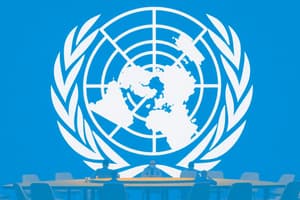Podcast
Questions and Answers
What is primarily regulated by Hague law?
What is primarily regulated by Hague law?
- The protection of victims of non-international armed conflicts
- Conditions for lawful self-defense
- Methods and means of warfare (correct)
- The treatment of prisoners of war
Which statement best describes the Additional Protocols adopted in 1977?
Which statement best describes the Additional Protocols adopted in 1977?
- They were universally praised and accepted without controversy.
- They were ratified by all major states without exception.
- They provide regulations specifically for both international and non-international armed conflicts. (correct)
- They focus exclusively on the treatment of shipwrecked members of armed forces.
Which of the following states did not ratify the Additional Protocols due to their controversial nature?
Which of the following states did not ratify the Additional Protocols due to their controversial nature?
- France
- Germany
- Japan
- United States (correct)
What does the Security Council's authority entail regarding measures taken for self-defence?
What does the Security Council's authority entail regarding measures taken for self-defence?
Which principle is generally associated with the right to self-defense in international law?
Which principle is generally associated with the right to self-defense in international law?
What condition must be met for self-defense to be considered lawful?
What condition must be met for self-defense to be considered lawful?
Which scenario raises ambiguity regarding the right to self-defence?
Which scenario raises ambiguity regarding the right to self-defence?
Which condition must be satisfied to lawfully exercise the right to self-defence?
Which condition must be satisfied to lawfully exercise the right to self-defence?
What principle requires a balance between the armed attack and the defensive measures taken?
What principle requires a balance between the armed attack and the defensive measures taken?
Which of the following is NOT considered an 'armed attack' that could invoke the right to self-defence?
Which of the following is NOT considered an 'armed attack' that could invoke the right to self-defence?
What type of action is often deemed necessary before invoking self-defence?
What type of action is often deemed necessary before invoking self-defence?
How does the principle of necessity affect self-defence actions?
How does the principle of necessity affect self-defence actions?
What is a limitation regarding the attack that triggers self-defence?
What is a limitation regarding the attack that triggers self-defence?
What is the primary authority granted to the Security Council by the UN Charter?
What is the primary authority granted to the Security Council by the UN Charter?
Which of the following best describes the ambiguity in applying the right to self-defense?
Which of the following best describes the ambiguity in applying the right to self-defense?
According to the UN Charter, Article 42 allows the Security Council to take what kind of enforcement actions?
According to the UN Charter, Article 42 allows the Security Council to take what kind of enforcement actions?
What principle does the right to self-defense under international law mainly depend upon?
What principle does the right to self-defense under international law mainly depend upon?
What condition is essential for the lawful exercise of self-defense according to international laws?
What condition is essential for the lawful exercise of self-defense according to international laws?
Which statement reflects a common misunderstanding regarding the use of force as defined in international law?
Which statement reflects a common misunderstanding regarding the use of force as defined in international law?
Which of the following is NOT a power of the Security Council as per the UN Charter?
Which of the following is NOT a power of the Security Council as per the UN Charter?
How does the UN Charter address the use of force based on consent from a host state?
How does the UN Charter address the use of force based on consent from a host state?
Flashcards
Additional Protocols to the Geneva Conventions
Additional Protocols to the Geneva Conventions
Important additions to the Geneva Conventions, focusing on protection of victims of armed conflict.
Hague law
Hague law
International law regulating the methods and means of warfare.
International Armed Conflicts
International Armed Conflicts
Conflicts between states or nations.
Non-International Armed Conflicts
Non-International Armed Conflicts
Signup and view all the flashcards
Geneva Conventions
Geneva Conventions
Signup and view all the flashcards
Jus ad bellum
Jus ad bellum
Signup and view all the flashcards
Jus in bello
Jus in bello
Signup and view all the flashcards
UN Charter
UN Charter
Signup and view all the flashcards
Article 2(4) of the UN Charter
Article 2(4) of the UN Charter
Signup and view all the flashcards
Force
Force
Signup and view all the flashcards
Consent
Consent
Signup and view all the flashcards
Security Council
Security Council
Signup and view all the flashcards
Veto Powers
Veto Powers
Signup and view all the flashcards
Armed Attack
Armed Attack
Signup and view all the flashcards
Self-Defence Conditions
Self-Defence Conditions
Signup and view all the flashcards
Necessity (Self-Defence)
Necessity (Self-Defence)
Signup and view all the flashcards
Proportionality (Self-Defence)
Proportionality (Self-Defence)
Signup and view all the flashcards
Private Actors and Self-Defence
Private Actors and Self-Defence
Signup and view all the flashcards
Self-Defence Reporting Requirement?
Self-Defence Reporting Requirement?
Signup and view all the flashcards
Security Council Authority in Self-Defence
Security Council Authority in Self-Defence
Signup and view all the flashcards
Ambiguity of Self-Defence
Ambiguity of Self-Defence
Signup and view all the flashcards
Study Notes
International Law: Armed Conflict
- War is a highly debated and politicized topic in international relations and law.
- International law comprises rules and principles governing the use of force.
- International law differentiates between jus ad bellum (when and why a state may use force) and jus in bello (how military hostilities should be conducted).
UN Charter
- The 1945 UN Charter aims to maintain international peace and prevent future major conflicts.
- The Charter entered into force on October 24, 1945.
- It generally discourages the use of force for resolving disputes, but establishes mechanisms for its lawful use.
Prohibition on the Use of Force
- Article 2(4) of the UN Charter prohibits member states from threatening or using force against another state's territorial integrity or political independence.
- The use of force is generally limited to armed measures.
- Non-armed forms of coercion, although potentially violating the principle of non-intervention, do not constitute force.
- A state's use of force with the consent of the host state is not prohibited.
The Security Council
- The UN Charter assigns the Security Council primary responsibility for maintaining international peace and security.
- The Security Council has 15 members; five (China, France, Russia, UK, and US) are permanent members with veto power.
- The Security Council has both binding and non-binding powers that include the use of force.
Determinations under Article 39
- The Security Council initially determines the existence of any threat to the peace, breach of the peace, or act of aggression.
- The Council has significant discretion in determining what constitutes a threat to the peace.
Provisional Measures under Article 40
- The Security Council can call on disputing parties to comply with provisional measures to prevent escalating situations.
- These can include ceasefires and troop withdrawals.
Non-Forcible Measures under Article 41
- The Security Council can impose non-coercive measures like economic sanctions or communication blockades.
Enforcement Measures under Article 42
- When non-coercive measures are insufficient, the Security Council can authorize the use of force by military action.
- The post-Cold War era saw an increase in Security Council activity focused on enforcement actions.
Right to Self-Defense
- Article 51 of the UN Charter recognizes the inherent right of individual or collective self-defense if an armed attack occurs.
- This right, however, is not limitless and is subject to conditions.
Restrictions on the Right to Self-Defense
- Necessity: A state must ascertain whether other peaceful means of redress are available before using force in self-defense.
- Proportionality: The measures taken in self-defense must be proportionate to the armed attack.
- Armed Attack: The triggering event for self-defense should be an armed attack of a specific intensity and seriousness (e.g., territorial invasion or widespread destruction).
Ambiguity on the Use of Force in Self-Defense
- Attacks by private actors: There's ongoing debate about whether attacks by non-state actors can trigger a right to self-defense.
- Anticipatory self-defense: While a state can make preparations for potential attack and bring the matter to the Security Council, a right to anticipatory use of force is generally recognized only when the threat of attack is imminent.
Law of Armed Conflict (LOAC)
- LOAC consists of jus ad bellum (rules regarding when and why war can be pursued) and jus in bello (rules governing the conduct of hostilities).
- Jus in bello, also known as International Humanitarian Law, aims to minimize suffering during armed conflict and protects vulnerable groups such as wounded soldiers, prisoners of war, healthcare providers, and civilians.
Geneva Law, Hague Law, and Additional Protocols
- These treaties establish specific rules regarding the treatment of wounded and sick individuals, prisoners of war, and civilian persons.
Studying That Suits You
Use AI to generate personalized quizzes and flashcards to suit your learning preferences.




